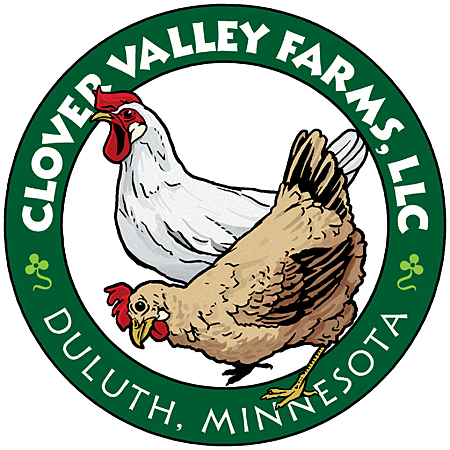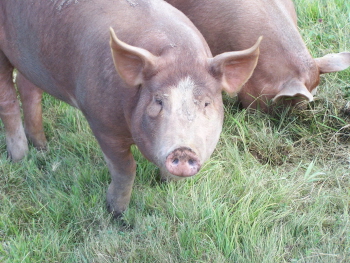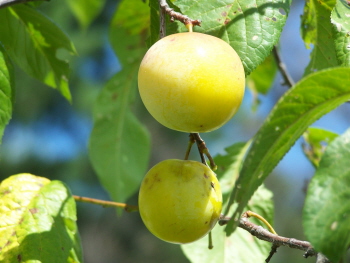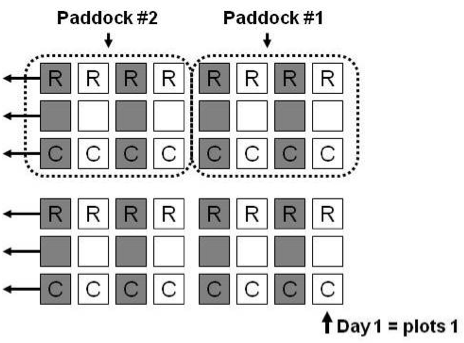On-Farm Research:
Integration of Poultry
and Hog Production
Cindy and Jeff received two 3-year grants from the Minnesota Department of Agriculture (MDA)’s Sustainable Agriculture Demonstration Grant Program and the USDA’s Sustainable Agriculture Research & Education program to conduct on-farm research. This research allows them to tailor their production methods to site conditions while increasing general knowledge about animal-based pasture rejuvenation and the productivity of pastured poultry.
Background
When Jeff and Cindy started up their poultry operation using Salatin-style pens in an old pasture, they noticed that the paths along which the pens moved throughout the season were not only greener and more productive the following year; they also appeared to contain more desirable plants, such as clovers, than did the unaffected pasture only a few feet away. Recommendations for pasture rejuvenation in their region generally include raking or tilling of the field; addition of soil amendments such as lime, phosphorus, potassium, or manure; and re-seeding; but they had not taken any of these steps. This led them to wonder if broilers could do the work of pasture restoration for them, while increasing the productivity of the broilers themselves through enhanced foraging opportunities in subsequent seasons. They also wondered about the potential for the hogs’ rooting behavior and hog manure to help with pasture rejuvenation.
Project Design
Cindy and Jeff set up an experimental block in their pasture, an old hayfield. The experimental area contained strips along which the hog paddock and broiler pens were moved throughout the 2010 season, which was the first year of the 3-year study. Some strips experienced no hog or broiler grazing, thus acting as controls. Alternate plots were seeded with a 50:50 white and red clover mix or left unseeded. This design allows them to test the pasture rejuvenation potential of hogs and two different breeds of broilers alone and in combination. They can also test whether seeding is required to enhance foraging after the grazing treatments. They will measure pasture rejuvenation by collecting plant samples to analyze for species composition and productivity; and broiler productivity by tracking amounts of feed used and bird weights at processing time.
|
|
Hogs were placed on pasture in the northeast corner of the experimental field block on April 25, 2010, and moved westward every 7 to 15 days, based on the level of rooting and sod break-up that had been achieved. The area covered by the 30’ x 40’ hog paddock (dotted lines) eventually encompassed twelve broiler plots. Chickens were placed on pasture on June 28, using 8’ x 10’ Salatin-style pens in one strip for combination with hog treatment and in another strip for the no-hog, control treatment. Pens were moved westward daily. “R” indicates pens containing 50 Red Broilers, “C” indicates pens containing 50 Cornish Broilers, and the blank boxes indicate the “no bird” controls. White boxes indicate seeded plots; gray boxes indicate non-seeded plots. |
Preliminary Results
Aerial photos (PDF, 326 kb) taken in 2009, before the start of the study; and in 2010 after one year of the study, clearly show the difference in vegetation in the area devoted to hog and chicken pasture. The contrast with the surrounding area is quite visible in the 2010 photo, compared to no visible difference between study area and surroundings in the 2009 photo.
Because 2010 was the first of the 3-year study, Cindy and Jeff did not expect to find meaningful differences in feed consumption rates or processing weights. The first year’s data will provide a baseline for measuring whether feed consumption rates and/or processing weights are affected by changes in the abundance or composition of pasture plants over time. They did observe striking differences in pasture appearance between strips grazed by chickens and strips not grazed by chickens.
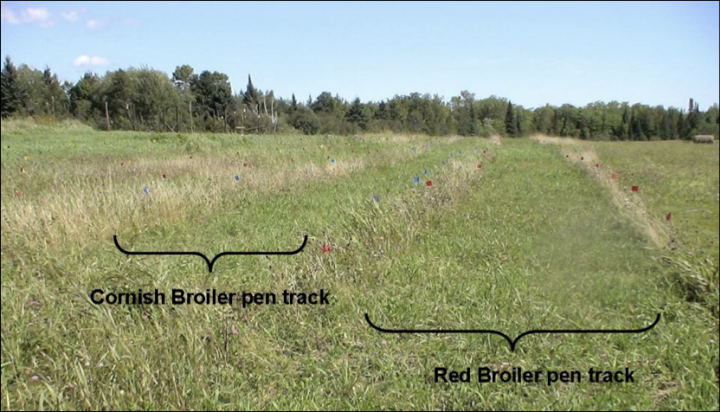
The strip on the right (large bracket) is the path followed by the Red Broiler pen; the strip on the left (small bracket) is the path followed by the Cornish Broiler pen. The narrow margin between the strips and the area to the far left in the picture show areas ungrazed by the chickens.
They also found that Cornish Broilers had much lower feed costs per bird than did Red Broilers, largely because it took 14 weeks to grow out the Red Broilers versus 8 weeks for the Cornish. Overall, the feed cost per finished pound of bird was $0.94 to $0.97 for Cornish and $1.60 to $2.23 for Red Broilers. Although Red Broilers forage better on pasture, it was not enough to reduce feed costs compared to the Cornish (though in 2011 they’ll be trying a different variety of Red Broiler; see Production > Harvest & Processing > Poultry).
There was no significant difference in feed costs for a given breed whether they grazed behind the hogs or grazed alone, but Cindy and Jeff hope that with increased pasture quality they will see better growth at a lower feed cost for Red Broilers. Cindy and Jeff recognize that Red Broilers may always be more expensive to raise than Cornish crosses because of different growth rates, and that typically the key to profitability would be to get a higher price for Red Broilers. They would, however, like to figure out the most economical way to raise Red Broilers, because their customers have been pleased with their flavor.
Farmer’s Perspective: On The Bookshelf In managing paddock and pasture vegetation for poultry and hog grazing, Jeff and Cindy have found these two publications to be useful: Invasive Plants of the Upper Midwest: An Illustrated Guide to Their Identification and Control By Elizabeth Czarapata, published by University of Wisconsin Press. By Dan Undersander, Michael Casler, and Dennis Cosgrove, available free in digital form from University of Wisconsin Extension. |
 |
 |
